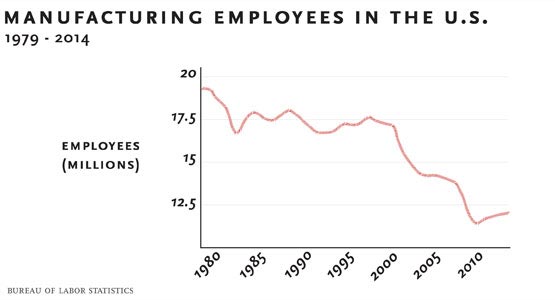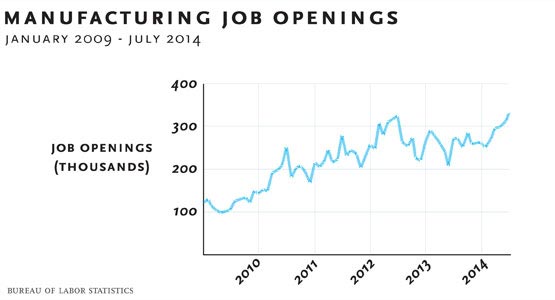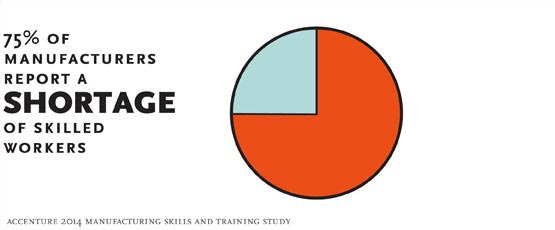
Dan Swinney bristles when he hears the words “postindustrial.”
“The U.S. is not postindustrial, OK?”
Nor should it be, he told the U.S. Federation of Worker Cooperatives when he keynoted their convention in his hometown of Chicago in May.
The United States has lost plenty of manufacturing jobs to other parts of the world. If we want to see the sort of systemic change we need in the United States, manufacturing things on a massive scale must be part of that vision, Swinney said. And it’s not about urging a return to the bad old days of the last industrial revolution—it’s about embracing a new industrial age, making things in new ways, and making the U.S. heartland hum again.
Factory work can be compatible with thriving communities and a healthy planet, Swinney said. “It depends whose values are in the driver’s seat.”
There are signs that American manufacturing is poised for a comeback. After years of over-a-cliff decline, the number of new manufacturing jobs has edged up over the past four years, and steadily all summer.
The country still has a long way to go. President Obama set a national goal in 2012 to create 1 million new manufacturing positions by the end of 2016—an aspiration some doubt we’ll reach. Still, the idea of creating these jobs gets people excited because they pay better and have greater impact on their communities than the low-wage work where growth has been concentrated up to now.
A manufacturing revival wouldn’t just be good for jobs and pay, Swinney says. “Manufacturing is the only way we’re going to lift people out of poverty, create strong local economies, and solve the challenge of climate change.”
“Drop the language about a postindustrial age,” Swinney told the co-op crowd. “You need to enter the new industrial age and attempt to lead it.”
But the question, Swinney said, is this: Will the Second Industrial Revolution look like the first, with its child labor, smokestacks, and profits for the few; or will it look like the cooperatively run factories of the Mondragon Corporation in the Basque region of Spain, or the democratically run industries of Italy’s Emilia Romagna district? There, worker-owners produce on an industrial scale, but in ways that prioritize the needs of their local community instead of profits for far-off investors.
 Graphic by Michelle Ney and Natalie Lubsen.
Graphic by Michelle Ney and Natalie Lubsen.
 Graphic by Michelle Ney and Natalie Lubsen.
Graphic by Michelle Ney and Natalie Lubsen.
Bringing business back to the Candy Capital
Swinney is a social-change-maker with a business plan. A former union machinist who saw his career in labor go up in smoke during the downturn of the 1980s, he’s pulled together a big tent partnership of public schools, private businesses, community groups, and labor. The goal is to harness the power of manufacturing for the empowerment of those most affected by the downfall of the last industrial revolution.
Thirty-two years ago, Swinney founded the research group Manufacturing Renaissance, which in 2005 spawned the Chicago Manufacturing Renaissance Council, the Bay Area Manufacturing Renaissance Council, and the National Manufacturing Renaissance Council.
This year, Manufacturing Renaissance went global, linking up with manufacturers and movements in Europe and soon, Swinney hopes, the developing South. For a project founded by a former union organizer, Swinney’s manufacturing revolution has a diverse set of fans: among them, the U.S. Department of Labor, the Mondragon cooperatives, and the U.S. Chamber of Commerce.
Now the job is selling manufacturing to young Chicagoans—most of whom associate factories with a bygone age.
It’s been a couple of generations since Chicago saw its heyday as the metal—and candy—capital of the United States. The brand names that were born here endure: names like Cracker Jack, Wrigley, and Baby Ruth; but only older residents recall smelling sugar in the air and telling the time by the shift-change siren ringing out from the Brach’s candy factory.
Darnell Shields Jr. remembers eating Brach’s butter toffees off the production line on family days. His father worked there, and colossal Brach was one of the last factories to close.
Shields experienced his father’s layoff and saw the place shuttered when new Swiss owners moved the business to Argentina in 2003. He chose to attend a vocational school because, “I grew up around those types of skills.”
The federal government started investing in public vocational education at the turn of the last century, when the last Industrial Revolution was creating more jobs than the trade guilds and the 19th-century apprentice system could fill. For decades, those schools were the training ground for high school students who planned to skip college and go directly into the trades or manufacturing. Factory life wasn’t for everyone, but it paid a wage on which you could raise a family, and promised a pension—at least before factories starting flooding South.
Shields, a parent now, is not promoting manufacturing to his kids. He got a degree in engineering and architecture, but he works in a community nonprofit.
“I saw the jobs go away and it didn’t seem viable,” he says.
Besides, before the founding of Austin Polytechnical Academy, a local manufacturing-focused college and prep school that partners with Manufacturing Renaissance, Shields’ kids would have had a hard time finding a place to get a technical education. His own high school closed the year after he graduated.
In the 1980s and ’90s, Manufacturing Renaissance reports, about 4,000 of Chicago’s 7,000 factories closed, sucking away 200,000 jobs. Not long after, as part of a national trend, local high schools started cutting shop class and disparaging “vocational ed” in favor of pushing everyone to college.
The intentions weren’t all bad. But beyond the school walls, where there had once been thriving businesses, caverns of deep urban poverty were opening up—especially in black and Latino communities like the Austin area of Chicago’s West Side. The taco shops, car wash joints, and snack food stores where factories had stood didn’t offer a career path, a pension, or wages that could come anywhere close to paying for college.
Swinney had time to study all this when he lost his job in 1983 after the Taylor Forge metal company closed its doors. A union organizer with experience in the United Steelworkers, Swinney formed a research group to study what was happening.
He found that some companies were outsourcing to find cheap, compliant labor, and some were put out of business by competition or speculators. But others were closing for simple lack of a succession plan, and a good number were determined to stay—though they were having a hard time.
With so much focus on what had been lost in the Candy Capital, educators, politicians, and social movements had failed to see what remained: Chicago was still one of the manufacturing capitals of the United States.
According to a report by Manufacturing Renaissance, 750 manufacturing companies do business in the city’s depressed West Side; 3,500 operate within 10 miles.
And it’s not just Chicago: Across the country, 600,000 manufacturing jobs are going unfilled.
A school-to-shop-floor pipeline
Freedman Seating has been making things people sit on for 120 years: first, for horse-drawn buggies; now, for delivery trucks and transit buses.
Craig Freedman is the last in a long line of Freedmans who grew up sweeping scraps of upholstery off the shop floor and working summers in the plant. He attended business school and spent a couple of years on Wall Street (he’s pretty sure he was the only one in his class who’d held a factory broom in his hand).
When his father got ready to retire, Freedman came back to Chicago. “It’s in my blood,” he said.
Is seating in his children’s blood? He doesn’t know, but qualified manufacturing staff is already scarce.
The company has been growing. Last year, it won a contract to produce more than 11,000 new lightweight seats for the Chicago Transit Authority’s latest fleet of buses. The company added 100 jobs in 2013, and more this year. The jobs pay $12-$25 an hour, but they’re hard to fill because qualified workers are in hot demand and few places train unskilled workers in upholstery and engineering.
According to an survey of 300 manufacturing executives by the consulting firm Accenture, 75 percent of those surveyed reported a moderate to severe shortage of skilled workers, and manufacturing workers are getting older (the proportion of workers who are over 65 years old is growing).
The Society of Manufacturing Engineers predicts that the shortfall of skilled factory workers could increase to 3 million jobs by 2015 due to the aging of the manufacturing workforce and older workers retiring.
“It’s more and more difficult to hire for skilled positions,” said Freedman, “partly because of the aging of our population and partly because the sophistication of manufacturing has changed so much.”
 Graphic by Michelle Ney and Natalie Lubsen.
Graphic by Michelle Ney and Natalie Lubsen.
 Graphic by Michelle Ney and Natalie Lubsen.
Graphic by Michelle Ney and Natalie Lubsen.
Americans started turning away from manufacturing (and cutting shop class) in pursuit of the “knowledge economy” just as manufacturing was getting modern and complex.
Since 2008, Swinney’s had help from his daughter, Erica Swinney. Erica left Chicago for California to attend college at the University of California, Berkeley, but returned to her old hometown after graduating.
Today, she serves as program director for Manufacturing Renaissance at Austin Polytechnic. She and her team have help from 60 privately owned companies—like Freedman Seating—who agree to give their high school students on-the-job experience and a fair crack at job placements.
In return, Manufacturing Renaissance trains Austin students on the latest computer and metalworking skills, and offers them a chance to win nationally recognized credentials.
Of the class of 2014, Erica estimates that about 45 graduates are enrolling in higher education or pursuing jobs in manufacturing (that’s 5 percent of the total class); and 62 percent have earned at least one machine-working credential from the National Institute for Metalworking Skills (NIMS). Many had earned two or three.
Although it’s still a tiny school, students at Austin Polytechnical Academy accounted for 56 percent of all NIMS credentials earned by high school students in Illinois in 2013. Since 2011, 28 have been placed in full-time jobs.
The Department of Labor is impressed enough that earlier this year, it gave Manufacturing Renaissance a 4-year grant of $2.7 million to fund a “Manufacturing Connect” program, which Swinney is confident will make the school-to-shop-floor route even smoother.
One of the beneficiaries is likely to be 21-year-old TreVon Dotson. Like most of the kids he knows, he didn’t grow up thinking about making things.
“I grew up wanting to be Godzilla,” Dotson said earlier this year.
More seriously, he describes himself as “lost” like many of his friends, until he got a sense of his own abilities and a taste of computer programming at Austin Poly.
Hooked up with a job-shadowing experience at Dudek Manufacturing, a custom-order metal corporation on Armitage Avenue that partners with Manufacturing Renaissance, Dotson was hired at Dudek not long after graduation. He was proud that he and his teammates manufactured components for the Weber Grill. The work’s not easy, Dotson explained, but he loved it. It made him feel needed.
“I’m needed to run the machine, and we’re making things people need,” he said. “That helps America and it helps other people. It’s like giving it forward.”
Since then, Dotson’s road has gotten rockier. Dudek let him go later earlier this year. While the company didn’t return calls for comment, Dotson says he’d made a mistake on a machine and soon afterward he was told it wasn’t a good fit. (Dudek has hired two other graduates from Austin Poly since, according to Erica Swinney.)
What Dotson has—that many young workers don’t—is a place he can go for help.
Among the academy’s partners is the community organization, Austin Coming Together (ACT), where former Brach’s candy child Darnell Shields works. ACT gives the students at Austin Poly the wraparound social supports many need to deal with stresses beyond the school walls—especially the problems associated with chronic poverty: “Drug addiction, alcoholism, long-term unemployment in their families,” Shields said. The list is long.
Dotson still wants to work in manufacturing. The pay was good. The way it made him feel about himself was good. He may be the first in his family to work in the industry (that he knows of), but he doesn’t want to be the last.
Just a few days after being let go, he went back to Austin Poly to meet with Erica. “Our teachers told us we could always come back, and that really meant a lot,” he said this August.
What the companies and community groups at Manufacturing Renaissance are doing at Austin Polytechnic is less about job placement than it is about stitching up a torn social fabric. It’s about equipping kids (and in their night classes, adults) with the skills they need to have a chance.
But the Swinneys’ real priority is improving those chances, for the sake of the community, the economy, and ultimately, the planet.
“The standard for most schools is to prep kids for college,” Swinney said. “That’s just a portal for kids to flee the community with no idea of what they’re going to do. The purpose of our school is to build the community and to learn all the skills that are necessary for that.”
That’s why they’re in Austin, not the suburbs. That’s why they’re working within the public school system, not setting up a private charter. That’s why they’re focusing on industry.
“Unless you’re talking about manufacturing, you’re not talking about transforming the economy,” Swinney said.
A blue-collar revival
Economists calculate that every job created in manufacturing generates 4-5 others in the supply chain, or in the neighborhood where better-paid employees live, Swinney told me. In retail, the estimate is 1.5 jobs; in service, it’s a quarter of a job.
“If ballet had the same multiplier effect, we’d be starting ballet schools,” Erica said.
The “new” economy is spawning a new culture where our dichotomies need an update.
As Matthew Crawford, author of The New York Times’ best-seller Shop Class as Soulcraft observes, the divide between white-collar and blue-collar—corresponding to “mental” versus “manual”—is a relic.
“First, it assumes that all blue-collar work is as mindless as assembly line work, and second, that white-collar work is still recognizably mental in character,” Crawford writes. “Yet there is evidence to suggest that the new frontier of capitalism lies in doing to office work what was previously done to factory work: draining it of its cognitive elements.”
“Paradoxically,” Crawford continues, “educators who would steer students toward cognitively rich work might do this best by rehabilitating the manual trades, based on a firmer grasp of what such work is really like.”
Assembly lines are already different—and can be more so. Part of what’s driving what The Atlantic called “The Insourcing Boom” is the recognition that offshoring puts such distance between manufacture and design that it is hard to respond nimbly to changes in consumer demand, and easy for foreign makers to knock off the product. Go one step further and make the workers owners, and you eliminate that distance.
Democracy at work is not just good for workers, it’s good for business, say the worker-owners at the New Era Windows cooperative.
At their plant, across town on Chicago’s South Side, the New Era workers had a chance to redesign their workplace when they started their own company and bought their equipment from their former boss.
“We do the work and we know how it goes,” said worker-owner Melvin “Ricky” Maclin. “When we worked for the boss, the workers had to move about a lot … Now we work for ourselves, we laid it out in a more efficient work flow.”
Swinney’s inspired by the cooperative model. The top-down, profit-up monopoly capitalism that’s brought our economy and our planet to the brink is not—despite what Margaret Thatcher said—”the only alternative.” Even as the first industrial revolution was crashing like the Brach candy factory’s chimney into rubble all over Chicago, social movements in Spain and Italy were creating huge, democratically run manufacturing companies. They were operated for profit, but that profit went to the workers and the community, serving the public interest.
“You can have growth like cancer or growth like a baby,” as Swinney sees it. The point is, the underlying values drive the ship.
Cooperation Capital, USA
At Austin, a lot of students can rattle off the high school’s values, which include promoting sustainability on a local and global level. Given the chance, those are the values students like Azariah Hutchinson will take into their own business.
Hutchinson is one of four female students running a business cooperative out of what started in shop class at Austin Poly. This February, she displayed delicately what she hopes to soon be selling: a small, brass trumpet mouthpiece.
The idea for the mouthpiece came from her teacher, Pablo Varela. He’s a keen trumpet player, but playing is hard. He set his students the task of making a product that might be easier to blow.
After many months of calculations and programming on Austin’s computer-controlled machines, the group came up with three models. They have a patent on one. It’s called Euterpe, after the Greek muse of music. Now, Hutchinson and her colleagues are just trying to perfect the code that will get the machine to imprint the little goddess logo on the brass.
“I don’t know if I’ll go into metalworking for my career, but I’m very interested in marketing and sales,” Hutchinson says.
Career, sales, metal, shop … None of these words played much of a role in Hutchinson’s life before she came to Austin Poly, she said: “Without this class I would have known nothing about manufacturing, factories, the jobs, any of it.”
Looking to the future, Swinney has his sights set on the next step. Having built a pipeline for qualified workers, he’s ready to woo new companies to Chicago.
That’s the idea behind the Austin Manufacturing Innovation District. With funding from part of a $1.25 million grant in 2012 from the City of Chicago, Chicago Manufacturing Renaissance Council, and Manufacturing Renaissance have proposed a production, research, development, and training facility in the Austin area.
On the day he spoke to the U.S. Federation of Worker Cooperatives convention, Swinney said they were close to an agreement with a company to build a factory and hire people on Chicago’s West Side (the agreement was finalized October 1). There are 13 more companies—including seven international companies—that have signed MOUs to explore siting production within the Innovation District.
“If all goes well we could be responsible for 400-600 new manufacturing jobs in the next 18 months.”
One site within the district that has enormous symbolic appeal is the 27-acre Brach candy site that now sits empty. The factory’s demolition made for quite a spectacle, the noise heard all across the West Side.
Could Chicago’s Second Industrial Revolution turn the Candy Capital into the Cooperation Capital—and make a different sort of boom?
Join us in defending the truth before it’s too late
The future of independent journalism is uncertain, and the consequences of losing it are too grave to ignore. To ensure Truthout remains safe, strong, and free, we need to raise $24,000 by the end of today. Every dollar raised goes directly toward the costs of producing news you can trust.
Please give what you can — because by supporting us with a tax-deductible donation, you’re not just preserving a source of news, you’re helping to safeguard what’s left of our democracy.